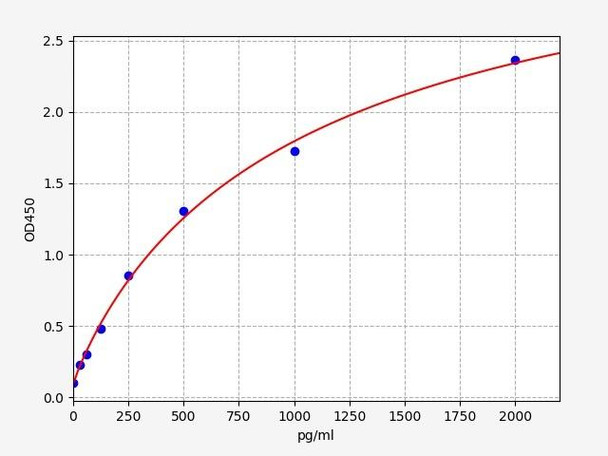CD59 encodes a cell surface glycoprotein that regulates complement-mediated cell lysis and lymphocyte signal transduction. CD59 is a potent inhibitor of the complement membrane attack complex, whereby it binds complement C8 and/or C9 during the assembly of this complex and prevents osmolytic pore formation. CD59 also plays a role in signal transduction pathways in the activation of T cells. Mutations in CD59 cause CD59 deficiency, a disease resulting in hemolytic anemia and thrombosis, and which causes cerebral infarction.
Description
Human CD59 ELISA Kit
Key Features
| Save Time | Pre-coated 96 well plate | |
| Quick Start | Kit includes all necessary reagents | |
| Publication Ready | Reproducible and reliable results |
Overview
| Product Name: | Human CD59 ELISA Kit |
| Product Code: | HUFI01776 |
| Size: | 96 Assays |
| Alias: | CD59, HRF20, MACIF, MIC11, Protectin, 16.3A5, 1F5, 1F5 antigen, 20 kDa homologous restriction factor, CD59 antigen, CD59 antigen p18-20, antigen identified by monoclonal antibodies 16.3A5, EJ16, CD59 antigen |
| Detection Method: | Sandwich ELISA, Double Antibody |
| Application: | This immunoassay kit allows for the in vitro quantitative determination of Human CD59 concentrations in serum plasma and other biological fluids. |
| Sensitivity: | 18.75pg/ml |
| Range: | 31.25-2000pg/ml |
| Storage: | 4°C for 6 months |
| Note: | For Research Use Only |
Additional Information
| Recovery: | Matrices listed below were spiked with certain level of Human CD59 and the recovery rates were calculated by comparing the measured value to the expected amount of Human CD59 in samples.
| ||||||||||||||||||||
| Linearity: | The linearity of the kit was assayed by testing samples spiked with appropriate concentration of Human CD59 and their serial dilutions. The results were demonstrated by the percentage of calculated concentration to the expected.
| ||||||||||||||||||||
| CV(%): | Intra-Assay: CV<8% |
Kit Components
| Component | Quantity | Storage |
| ELISA Microplate (Dismountable) | 8x12 strips | 4°C for 6 months |
| Lyophilized Standard | 2 | 4°C/ -20°C |
| Sample/Standard Dlution Buffer | 20ml | 4°C |
| Biotin-labeled Antibody (Concentrated) | 120ul | 4°C (Protection from light) |
| Antibody Dilution Buffer | 10ml | 4°C |
| HRP-Streptavidin Conjugate (SABC) | 120ul | 4°C (Protect from light) |
| SABC Dilution Buffer | 10ml | 4°C |
| TMB Substrate | 10ml | 4°C (Protection from light) |
| Stop Solution | 10ml | 4°C |
| Wash Buffer (25X) | 30ml | 4°C |
| Plate Sealer | 5 | - |
Other materials required:
- Microplate reader with 450 nm wavelength filter
- Multichannel Pipette, Pipette, microcentrifuge tubes and disposable pipette tips
- Incubator
- Deionized or distilled water
- Absorbent paper
- Buffer resevoir
Protein Information
| Uniprot: | |
| UniProt Protein Function: | CD59: Potent inhibitor of the complement membrane attack complex (MAC) action. Acts by binding to the C8 and/or C9 complements of the assembling MAC, thereby preventing incorporation of the multiple copies of C9 required for complete formation of the osmolytic pore. This inhibitor appears to be species-specific. Involved in signal transduction for T-cell activation complexed to a protein tyrosine kinase. Defects in CD59 are the cause of CD59 deficiency (CD59D). |
| UniProt Code: | |
| NCBI GenInfo Identifier: | |
| NCBI Gene ID: | |
| NCBI Accession: | |
| UniProt Related Accession: | |
| Molecular Weight: | 14kDa |
| NCBI Full Name: | CD59 glycoprotein |
Protocol
*Note: Protocols are specific to each batch/lot. For the exact instructions please follow the protocol included in your kit.
Before adding to wells, equilibrate the SABC working solution and TMB substrate for at least 30 min at 37°C. When diluting samples and reagents, they must be mixed completely and evenly. It is recommended to plot a standard curve for each test.
| Step | Procedure |
| 1. | Set standard, test sample and control (zero) wells on the pre-coated plate respectively, and then, record their positions. It is recommended to measure each standard and sample in duplicate. Wash plate 2 times before adding standard, sample and control (zero) wells! |
| 2. | Aliquot 0.1ml standard solutions into the standard wells. |
| 3. | Add 0.1 ml of Sample / Standard dilution buffer into the control (zero) well. |
| 4. | Add 0.1 ml of properly diluted sample ( Human serum, plasma, tissue homogenates and other biological fluids.) into test sample wells. |
| 5. | Seal the plate with a cover and incubate at 37 °C for 90 min. |
| 6. | Remove the cover and discard the plate content, clap the plate on the absorbent filter papers or other absorbent material. Do NOT let the wells completely dry at any time. Wash plate X2. |
| 7. | Add 0.1 ml of Biotin- detection antibody working solution into the above wells (standard, test sample & zero wells). Add the solution at the bottom of each well without touching the side wall. |
| 8. | Seal the plate with a cover and incubate at 37°C for 60 min. |
| 9. | Remove the cover, and wash plate 3 times with Wash buffer. Let wash buffer rest in wells for 1 min between each wash. |
| 10. | Add 0.1 ml of SABC working solution into each well, cover the plate and incubate at 37°C for 30 min. |
| 11. | Remove the cover and wash plate 5 times with Wash buffer, and each time let the wash buffer stay in the wells for 1-2 min. |
| 12. | Add 90 µl of TMB substrate into each well, cover the plate and incubate at 37°C in dark within 10-20 min. (Note: This incubation time is for reference use only, the optimal time should be determined by end user.) And the shades of blue can be seen in the first 3-4 wells (with most concentrated standard solutions), the other wells show no obvious color. |
| 13. | Add 50 µl of Stop solution into each well and mix thoroughly. The color changes into yellow immediately. |
| 14. | Read the O.D. absorbance at 450 nm in a microplate reader immediately after adding the stop solution. |
Sample Type
When carrying out an ELISA assay it is important to prepare your samples in order to achieve the best possible results. Below we have a list of procedures for the preparation of samples for different sample types.
| Sample Type | Protocol |
| Serum | If using serum separator tubes, allow samples to clot for 30 minutes at room temperature. Centrifuge for 10 minutes at 1,000x g. Collect the serum fraction and assay promptly or aliquot and store the samples at -80°C. Avoid multiple freeze-thaw cycles. If serum separator tubes are not being used, allow samples to clot overnight at 2-8°C. Centrifuge for 10 minutes at 1,000x g. Remove serum and assay promptly or aliquot and store the samples at -80°C. Avoid multiple freeze-thaw cycles. |
| Plasma | Collect plasma using EDTA or heparin as an anticoagulant. Centrifuge samples at 4°C for 15 mins at 1000 × g within 30 mins of collection. Collect the plasma fraction and assay promptly or aliquot and store the samples at -80°C. Avoid multiple freeze-thaw cycles. Note: Over haemolysed samples are not suitable for use with this kit. |
| Urine & Cerebrospinal Fluid | Collect the urine (mid-stream) in a sterile container, centrifuge for 20 mins at 2000-3000 rpm. Remove supernatant and assay immediately. If any precipitation is detected, repeat the centrifugation step. A similar protocol can be used for cerebrospinal fluid. |
| Cell culture supernatant | Collect the cell culture media by pipette, followed by centrifugation at 4°C for 20 mins at 1500 rpm. Collect the clear supernatant and assay immediately. |
| Cell lysates | Solubilize cells in lysis buffer and allow to sit on ice for 30 minutes. Centrifuge tubes at 14,000 x g for 5 minutes to remove insoluble material. Aliquot the supernatant into a new tube and discard the remaining whole cell extract. Quantify total protein concentration using a total protein assay. Assay immediately or aliquot and store at ≤ -20 °C. |
| Tissue homogenates | The preparation of tissue homogenates will vary depending upon tissue type. Rinse tissue with 1X PBS to remove excess blood & homogenize in 20ml of 1X PBS (including protease inhibitors) and store overnight at ≤ -20°C. Two freeze-thaw cycles are required to break the cell membranes. To further disrupt the cell membranes you can sonicate the samples. Centrifuge homogenates for 5 mins at 5000xg. Remove the supernatant and assay immediately or aliquot and store at -20°C or -80°C. |
| Tissue lysates | Rinse tissue with PBS, cut into 1-2 mm pieces, and homogenize with a tissue homogenizer in PBS. Add an equal volume of RIPA buffer containing protease inhibitors and lyse tissues at room temperature for 30 minutes with gentle agitation. Centrifuge to remove debris. Quantify total protein concentration using a total protein assay. Assay immediately or aliquot and store at ≤ -20 °C |
| Breast Milk | Collect milk samples and centrifuge at 10,000 x g for 60 min at 4°C. Aliquot the supernatant and assay. For long term use, store samples at -80°C. Minimize freeze/thaw cycles. |
CD59 Background
CD59, also known as protectin or membrane inhibitor of reactive lysis (MIRL), is a protein that plays a crucial role in the regulation of the complement system. The complement system is a part of the immune system that helps in the defense against pathogens and the clearance of damaged cells.
Structure and Function of CD59
CD59 is a glycosylphosphatidylinositol (GPI)-anchored protein, meaning it is attached to the cell membrane by a GPI anchor. It is expressed on the surface of various cell types, including red blood cells, leukocytes, and endothelial cells. CD59 acts as a complement regulatory protein by inhibiting the formation of the membrane attack complex (MAC), a structure that can form on cell membranes and cause cell lysis.
Role of CD59 in Complement Regulation
The MAC is formed as a result of the complement cascade, which involves a series of proteolytic reactions leading to the activation of complement proteins. The final step of this cascade is the assembly of the MAC, which can penetrate and disrupt cell membranes, leading to cell death. CD59 prevents the assembly and insertion of the MAC into the cell membrane, thereby protecting cells from complement-mediated lysis.
CD59 Deficiency and Paroxysmal Nocturnal Hemoglobinuria (PNH)
Deficiencies or abnormalities in CD59 can lead to an increased susceptibility to complement-mediated damage. For example, individuals with paroxysmal nocturnal hemoglobinuria (PNH) have a deficiency in CD59 and other complement regulatory proteins, which results in the destruction of red blood cells by the complement system. PNH is a rare acquired disorder characterized by episodes of hemolysis, blood clotting, and impaired bone marrow function.
CD59 FAQs
What is the CD59 ELISA Kit?
The Human CD59 ELISA Kit is a specialized research tool designed to measure the levels of CD59 protein in human samples.
What are the advantages of using the CD59 ELISA Kit?
The Human CD59 ELISA Kit offers several advantages for researchers. It provides a reliable and quantitative measurement of CD59 protein levels, enabling detailed investigations into its role in complement system regulation and associated research areas.
Where can I find more information about the CD59 ELISA Kit?
For more detailed information about the CD59 ELISA Kit, including technical specifications, performance characteristics, and ordering details, please refer to the product brochure or contact our customer support team. We are here to assist you with any inquiries you may have.






